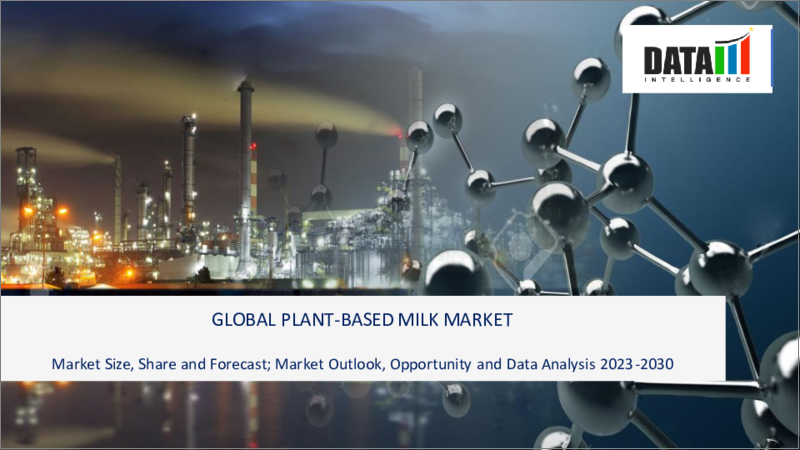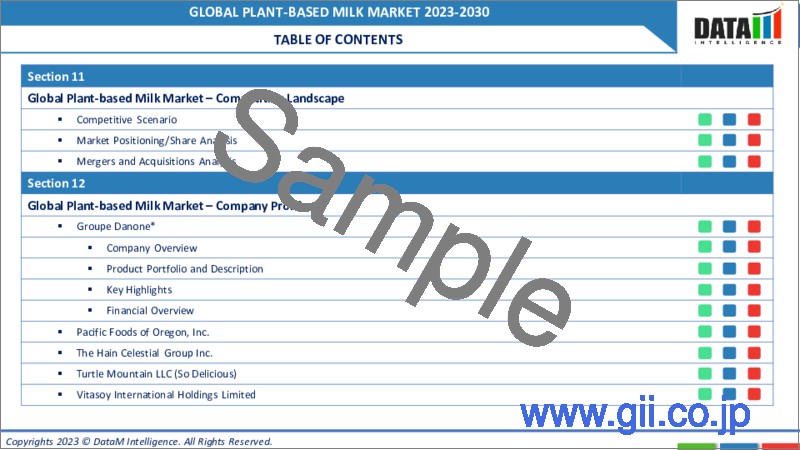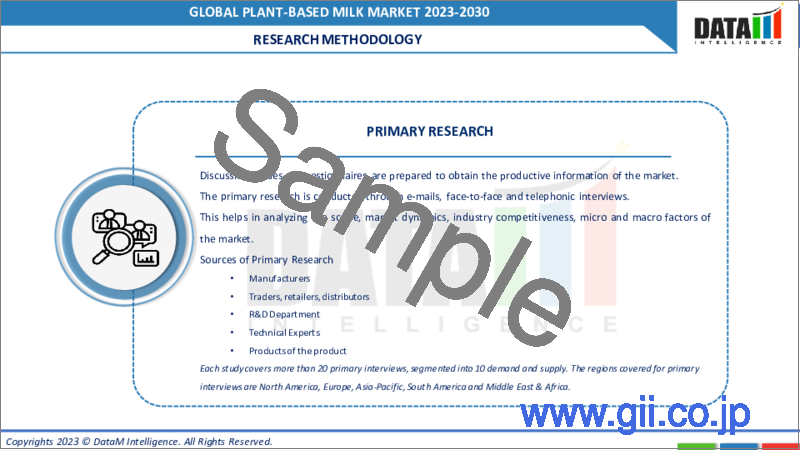|
|
市場調査レポート
商品コード
1319244
植物性ミルクの世界市場-2023年~2030年Global Plant-based Milk Market - 2023-2030 |
||||||
カスタマイズ可能
適宜更新あり
|
|||||||
| 植物性ミルクの世界市場-2023年~2030年 |
|
出版日: 2023年07月31日
発行: DataM Intelligence
ページ情報: 英文 190 Pages
納期: 即日から翌営業日
|
- 全表示
- 概要
- 目次
市場概要
植物性ミルクの世界市場は、2022年に186億米ドルに達し、2023年から2030年の予測期間中にCAGR 9.5%で成長し、2030年には384億米ドルに達すると予測されています。
植物性ミルクとは、植物資源に由来し、従来の乳製品の代替品となる飲料のことです。これらの代替ミルクは、非乳製品ミルク、乳製品不使用ミルク、またはナッツミルクと呼ばれることが多いです。アーモンドミルクは、床のアーモンドと水から作られます。ナッツのような風味はほとんどなく、乳製品のミルクに比べて軽い粘度があります。ココナッツミルクは、成熟したココナッツの果肉から作られます。濃厚でクリーミーなテクスチャーとトロピカルな風味が特徴です。ココナッツミルクはアジア料理によく使われ、植物性のケーキやカレーにもよく使われます。
植物性ミルク市場は、利用可能な製品の種類の中で広範な成長を示しています。メーカー各社は、様々な利用者の可能性に応えるため、進歩的なフレーバー、ブレンド、配合を導入しています。例えば、エンドウ豆ミルク、カシューミルク、ヘンプミルクなど、興味のある分野の選択肢が急増し、顧客はより幅広い植物性ミルクの選択肢から選ぶことができるようになっています。
市場力学
世界の消費者の健康・ウェルネス意識の高まりが植物性ミルク市場を牽引
植物性ミルクはしばしば、乳製品に代わるより健康的なミルクとして認識されています。一般に飽和脂肪酸やコレステロールが少なく、栄養素、ミネラル、植物性タンパク質などの有益な栄養素がさらに含まれている可能性があります。フィットネスと健康を優先する消費者は、食生活の選択肢の一部として植物性ミルクを選んでいます。
ヴィーガンや植物ベースの食生活は、世界的に増加傾向にあります。例えば、ヴィーガン協会によると、2022年には世界のヴィーガン人口は62万9000人を超えると言われています。人々は、健康、倫理、持続可能性など、さまざまなことを動機としています。植物性ミルクは、これらの栄養選択に従う人々に自然に適合し、マーケットプレースの成長をさらに促進します。
倫理と動物福祉への配慮が植物性ミルク市場を促進すると予想される
畜産業界の状況や慣行に対する意識の高まりが消費者の選択に影響を与えています。消費者は、工場畜産、監禁システム、動物の扱いなどの問題に懸念を抱いており、そのため植物性ミルクのような代替品を求めるようになっています。この倫理的配慮が植物性ミルク市場の成長を後押ししています。
ミレニアル世代やZ世代などの若い世代は、購買決定において倫理的配慮を優先することが知られています。彼らは、動物福祉を優先するブランドを含め、自分たちの価値観に沿ったブランドを支持する傾向が強いです。これらの世代が重要な消費者層を占めていることから、彼らの倫理的関心が植物性ミルク市場を促進すると予想されます。
フードサービスとホスピタリティの供給が限られていることが植物性ミルク市場の妨げとなっています
コーヒーショップは、ラテやカプチーノといったミルクベースの飲料の消費において重要な役割を果たしています。しかし、コーヒーショップで植物由来の代替ミルクを利用できるかは様々で、品揃えが限られていたり、植物由来のオプションに追加料金がかかる場合もあります。このような限られた品揃えは、消費者が植物性ミルクを選ぶことを躊躇させ、市場の成長を妨げる可能性があります。
ホスピタリティ分野でのメニュー開発に植物性乳代替食品を取り入れるには限界があります。例えば、米国では植物性食品の売上が過去3年間で44.5%増加しています。ホテル、リゾート、ケータリング・サービスでは、植物性乳の多様な選択肢を十分に取り入れていない可能性があり、こうした環境では消費者の選択肢が制限される可能性があります。
COVID-19影響分析
COVID-19分析には、COVID前シナリオ、COVIDシナリオ、COVID後シナリオに加え、価格力学(COVID前シナリオと比較したパンデミック中およびパンデミック後の価格変動を含む)、需給スペクトラム(取引制限、封鎖、およびその後の問題による需給の変化)、政府の取り組み(政府機関による市場、セクター、業界を復興させる取り組み)、メーカーの戦略的取り組み(COVID問題を緩和するためにメーカーが行ったことをここで取り上げる)が含まれます。
目次
第1章 調査手法と調査範囲
第2章 市場の定義と概要
第3章 エグゼクティブサマリー
第4章 市場力学
- 市場への影響要因
- 促進要因
- ビーガン食品・飲食品に対する消費者の志向の高まり
- 抑制要因
- 植物性ミルクの価格敏感性
- 機会
- 乳糖不耐症の消費者の増加
- 影響分析
- 促進要因
第5章 産業分析
- ポーターのファイブフォース分析
- サプライチェーン分析
- 価格分析
- 規制分析
第6章 COVID-19分析
第7章 供給源別
- 豆乳
- アーモンドミルク
- ココナッツミルク
- ライスミルク
- その他
第8章 パッケージ別
- ボトル
- カートン包装
- パウチ
第9章 流通チャネル別
- 小売店
- オンライン販売
- 専門店
- その他
第10章 地域別
- 北米
- 米国
- カナダ
- メキシコ
- 欧州
- ドイツ
- 英国
- フランス
- イタリア
- スペイン
- その他欧州
- 南米
- ブラジル
- アルゼンチン
- その他南米
- アジア太平洋
- 中国
- インド
- 日本
- オーストラリア
- その他アジア太平洋地域
- 中東・アフリカ
第11章 競合情勢
- 競合シナリオ
- 市況/シェア分析
- M&A分析
第12章 企業プロファイル
- Groupe Danone
- 会社概要
- 製品ポートフォリオと説明
- 財務概要
- 主な発展
- Pacific Foods of Oregon, Inc.
- The Hain Celestial Group Inc.
- Turtle Mountain LLC
- Vitasoy International Holdings Limited
- Natura Foods, Sunopta Inc.
- Freedom Foods Group Ltd.
- Earth's Own Food Company Inc.
- Mc Cormick & Co., Goya Foods
- The Hershey Company
第13章 付録
Market Overview
Global Plant-based Milk Market reached US$ 18.6 billion in 2022 and is expected to reach US$ 38.4 billion by 2030 growing with a CAGR of 9.5% during the forecast period 2023-2030.
Plant-based milk refers to a ramification of drinks that are derived from plant resources and serve as alternatives to conventional dairy milk. Those milk alternatives are frequently referred to as non-dairy milk, dairy-free milk, or nut milk. Almond milk is made from floor almonds and water. It has a barely nutty flavor and a lighter consistency compared to dairy milk. Coconut milk is derived from the flesh of mature coconuts. It has a rich, creamy texture and an awesome tropical flavor. Coconut milk is typically utilized in Asian cuisines and is likewise famous in plant-based cakes and curries.
The plant-primarily based milk market has witnessed widespread growth within the kind of available products. Manufacturers are introducing progressive flavors, blends, and formulations to cater to various patron possibilities. For instance, there has been a surge in the availability of area of interest options along with pea milk, cashew milk, and hemp milk, offering customers a much broader variety of plant-based milk options to pick out from.
Market Dynamics
Increasing Health and Wellness Awareness of Consumers Globally is Driving the Plant-based Milk Market
Plant-based milk is often perceived as a more fit alternative to dairy milk. It is generally lower in saturated fats and cholesterol and may contain additional beneficial nutrients like nutrients, minerals, and plant-based proteins. Consumers who prioritize fitness and health are selecting plant-based milk as a part of their dietary choices.
The adoption of vegan and plant-primarily based diets has been on the rise globally. For instance, according to the Vegan Society, in 2022, the global vegan population is over 629,000 people. People are motivated with the aid of a variety of things, inclusive of health, ethics, and sustainability. Plant-based milk is a natural fit for those following these nutritional picks, further driving the marketplace growth.
Ethical and Animal Welfare Considerations is Expected to Foster the Plant-based Milk Market
Increasing awareness about the conditions and practices within the animal agriculture industry has influenced consumer choices. Consumers are concerned about issues such as factory farming, confinement systems, and animal treatment, which has led them to seek alternatives like plant-based milk. This ethical consideration drives the growth of the plant-based milk market.
Younger generations, such as Millennials and Gen Z, are known to prioritize ethical considerations in their purchasing decisions. They are more likely to support brands that align with their values, including those that prioritize animal welfare. As these generations make up a significant consumer base, their ethical concerns are expected to foster the plant-based milk market.
Limited Availability in Foodservice and Hospitality is Holding Back the Plant-based Milk Market
Coffee shops play a significant role in the consumption of milk-based beverages, such as lattes and cappuccinos. However, the availability of plant-based milk alternatives in coffee shops varies, and some may have a limited selection or charge an additional fee for plant-based options. This limited availability can deter consumers from choosing plant-based milk and may hinder its market growth.
The inclusion of plant-based milk alternatives in menu development within the hospitality sector can be limited. For instance, plant-based foods sales have grown 44.5% percent in the US in the past three years. Hotels, resorts, and catering services may not fully embrace the diverse range of plant-based milk options in their offerings, which can restrict consumer choices in those settings.
COVID-19 Impact Analysis
The COVID-19 Analysis includes Pre-COVID Scenario, COVID Scenario, and Post-COVID Scenario along with Pricing Dynamics (Including pricing change during and post-pandemic comparing it with pre-COVID scenarios), Demand-Supply Spectrum (Shift in demand and supply owing to trading restrictions, lockdown, and subsequent issues), Government Initiatives (Initiatives to revive market, sector or Industry by Government Bodies) and Manufacturers Strategic Initiatives (What manufacturers did to mitigate the COVID issues will be covered here).
Segment Analysis
The global plant-based milk market is segmented based on source, packaging, distribution channel, and region.
By Distribution Channel, the Retail Store Segment is Estimated to have Significant Growth During the Forecast Period
Plant-based milk products are widely available in retail shops, inclusive of grocery stores, supermarkets, and specialty health fitness food shops. These stores cater to a huge purchaser base and offer an expansion of plant-based milk options, ranging from famous selections like almond milk and soy milk to newer options like oat milk and coconut milk. For instance, according to The Good Food Institute, the U.S. retail market for plant-based foods is worth $8 billion.
Retail stores offer convenient access to plant-based milk products for consumers. With their extensive presence, consumers can easily find plant-based milk in their neighborhood shops, making it accessible to a bigger target market. According to Good Food Institute, 6 in 10 U.S. households purchased plant-based foods in 2022, similar to the prior year. This accessibility contributes to the retail segment's dominance in the market.
Geographical Analysis
Asia Pacific is the Fastest Growing Market in the Plant-based Milk Market
Asia Pacific has experienced a notable shift in nutritional patterns, with more and more people adopting plant-based diets or lowering their intake of animal products. This shift is pushed by way of factors that includes fitness focus, ethical considerations, and spiritual beliefs. The growing adoption of plant-based diets in the area contributes to the growth of the plant-based milk market.
Asia Pacific is home to a great part of the global population, with several densely populated nations. For instance, according to Euromonitor, there are a total of 4.98 million vegetarians in APAC. Indeed, India has the largest vegetarian population in this region which is 3.68 million. Urbanization within the region has led to changing consumer possibilities and increased exposure to worldwide food trends. The massive population and concrete facilities provide a large consumer base for plant-based milk products, fueling a market boom.
Competitive Landscape
The major global players in the market include: Groupe Danone, Pacific Foods of Oregon, Inc., The Hain Celestial Group Inc., Turtle Mountain LLC, Vitasoy International Holdings Limited, Natura Foods, Sunopta Inc., Freedom Foods Group Ltd., Earth's Own Food Company Inc., Mc Cormick & Co., Goya Foods, and The Hershey Company.
Why Purchase the Report?
- To visualize the global plant-based milk market segmentation based on source, packaging, distribution channel, and region, as well as understand key commercial assets and players.
- Identify commercial opportunities in the market by analyzing trends and co-development.
- Excel data sheet with numerous data points of plant-based milk market-level with all segments.
- The PDF report consists of cogently put-together market analysis after exhaustive qualitative interviews and in-depth market study.
- Product mapping is available as Excel consists of key products of all the major market players.
The global plant-based milk market report would provide approximately 61 tables, 59 figures and 190 Pages.
Target Audience 2023
- Manufacturers/ Buyers
- Industry Investors/Investment Bankers
- Research Professionals
- Emerging Companies
Table of Contents
1. Methodology and Scope
- 1.1. Research Methodology
- 1.2. Research Objective and Scope of the Report
2. Market Definition and Overview
3. Executive Summary
- 3.1. Market Snippet, by Source
- 3.2. Market Snippet, by Packaging
- 3.3. Market Snippet, by Distribution Channel
- 3.4. Market Snippet, by Region
4. Market Dynamics
- 4.1. Market Impacting Factors
- 4.1.1. Drivers
- 4.1.1.1. Rising Consumer Inclination Towards Vegan Food and Beverages
- 4.1.2. Restraints
- 4.1.2.1. Price Sensitivity of Plant-based Milk
- 4.1.3. Opportunity
- 4.1.3.1. Growing Levels of Lactose Intolerance Consumers
- 4.1.4. Impact Analysis
- 4.1.1. Drivers
5. Industry Analysis
- 5.1. Porter's Five Force Analysis
- 5.2. Supply Chain Analysis
- 5.3. Pricing Analysis
- 5.4. Regulatory Analysis
6. COVID-19 Analysis
- 6.1. Analysis of COVID-19 on the Market
- 6.1.1. Scenario Before COVID-19
- 6.1.2. Scenario During COVID-19
- 6.1.3. Scenario Post COVID-19
- 6.2. Pricing Dynamics Amid COVID-19
- 6.3. Demand-Supply Spectrum
- 6.4. Government Initiatives Related to the Market During Pandemic
- 6.5. Manufacturers Strategic Initiatives
- 6.6. Conclusion
7. By Source
- 7.1. Introduction
- 7.1.1. Market Size Analysis and Y-o-Y Growth Analysis (%), By Source
- 7.1.2. Market Attractiveness Index, By Packaging
- 7.2. Soy Milk*
- 7.2.1. Introduction
- 7.2.2. Market Size Analysis and Y-o-Y Growth Analysis (%)
- 7.3. Almond Milk
- 7.4. Coconut Milk
- 7.5. Rice Milk
- 7.6. Other
8. By Packaging
- 8.1. Introduction
- 8.1.1. Market Size Analysis and Y-o-Y Growth Analysis (%), By Packaging
- 8.1.2. Market Attractiveness Index, By Packaging
- 8.2. Bottles*
- 8.2.1. Introduction
- 8.2.2. Market Size Analysis and Y-o-Y Growth Analysis (%)
- 8.3. Carton Packaging
- 8.4. Pouches
9. By Distribution Channel
- 9.1. Introduction
- 9.1.1. Market Size Analysis and Y-o-Y Growth Analysis (%), By Distribution Channel
- 9.1.2. Market Attractiveness Index, By Distribution Channel
- 9.2. Retail Stores*
- 9.2.1. Introduction
- 9.2.2. Market Size Analysis and Y-o-Y Growth Analysis (%)
- 9.3. Online Sales
- 9.4. Specialty Stores
- 9.5. Other
10. By Region
- 10.1. Introduction
- 10.1.1. Market Size Analysis and Y-o-Y Growth Analysis (%), By Region
- 10.1.2. Market Attractiveness Index, By Region
- 10.2. North America*
- 10.2.1. Introduction
- 10.2.2. Key Region-Specific Dynamics
- 10.2.3. Market Size Analysis and Y-o-Y Growth Analysis (%), By Source
- 10.2.4. Market Size Analysis and Y-o-Y Growth Analysis (%), By Packaging
- 10.2.5. Market Size Analysis and Y-o-Y Growth Analysis (%), By Distribution Channel
- 10.2.6. Market Size Analysis and Y-o-Y Growth Analysis (%), By Country
- 10.2.6.1. The U.S.
- 10.2.6.2. Canada
- 10.2.6.3. Mexico
- 10.3. Europe
- 10.3.1. Introduction
- 10.3.2. Key Region-Specific Dynamics
- 10.3.3. Market Size Analysis and Y-o-Y Growth Analysis (%), By Source
- 10.3.4. Market Size Analysis and Y-o-Y Growth Analysis (%), By Packaging
- 10.3.5. Market Size Analysis and Y-o-Y Growth Analysis (%), By Distribution Channel
- 10.3.6. Market Size Analysis and Y-o-Y Growth Analysis (%), By Country
- 10.3.6.1. Germany
- 10.3.6.2. The U.K.
- 10.3.6.3. France
- 10.3.6.4. Italy
- 10.3.6.5. Spain
- 10.3.6.6. Rest of Europe
- 10.4. South America
- 10.4.1. Introduction
- 10.4.2. Key Region-Specific Dynamics
- 10.4.3. Market Size Analysis and Y-o-Y Growth Analysis (%), By Source
- 10.4.4. Market Size Analysis and Y-o-Y Growth Analysis (%), By Packaging
- 10.4.5. Market Size Analysis and Y-o-Y Growth Analysis (%), By Distribution Channel
- 10.4.6. Market Size Analysis and Y-o-Y Growth Analysis (%), By Country
- 10.4.6.1. Brazil
- 10.4.6.2. Argentina
- 10.4.6.3. Rest of South America
- 10.5. Asia-Pacific
- 10.5.1. Introduction
- 10.5.2. Key Region-Specific Dynamics
- 10.5.3. Market Size Analysis and Y-o-Y Growth Analysis (%), By Source
- 10.5.4. Market Size Analysis and Y-o-Y Growth Analysis (%), By Packaging
- 10.5.5. Market Size Analysis and Y-o-Y Growth Analysis (%), By Distribution Channel
- 10.5.6. Market Size Analysis and Y-o-Y Growth Analysis (%), By Country
- 10.5.6.1. China
- 10.5.6.2. India
- 10.5.6.3. Japan
- 10.5.6.4. Australia
- 10.5.6.5. Rest of Asia-Pacific
- 10.6. Middle East and Africa
- 10.6.1. Introduction
- 10.6.2. Key Region-Specific Dynamics
- 10.6.3. Market Size Analysis and Y-o-Y Growth Analysis (%), By Source
- 10.6.4. Market Size Analysis and Y-o-Y Growth Analysis (%), By Packaging
- 10.6.5. Market Size Analysis and Y-o-Y Growth Analysis (%), By Distribution Channel
11. Competitive Landscape
- 11.1. Competitive Scenario
- 11.2. Market Positioning/Share Analysis
- 11.3. Mergers and Acquisitions Analysis
12. Company Profiles
- 12.1. Groupe Danone*
- 12.1.1. Company Overview
- 12.1.2. Product Portfolio and Description
- 12.1.3. Financial Overview
- 12.1.4. Key Developments
- 12.2. Pacific Foods of Oregon, Inc.
- 12.3. The Hain Celestial Group Inc.
- 12.4. Turtle Mountain LLC
- 12.5. Vitasoy International Holdings Limited
- 12.6. Natura Foods, Sunopta Inc.
- 12.7. Freedom Foods Group Ltd.
- 12.8. Earth's Own Food Company Inc.
- 12.9. Mc Cormick & Co., Goya Foods
- 12.10. The Hershey Company
LIST NOT EXHAUSTIVE
13. Appendix
- 13.1. About Us and Services
- 13.2. Contact Us






